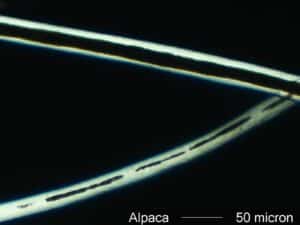written by: Allison Goins, Ph.D. | Published on December 11th, 2020 at 6:05 pm
Its winter time most people have busted out their winter clothing. If you want to be warm and fire-resistant, you might want to buy a sweater made out of a specific natural material, alpaca wool.
What are Alpacas?
Alpacas are native to South America and have been domesticated for about 5000 years. Alpacas naturally live high in the mountains. Due to their natural habitat, they have a versatile wool coat. There are claims that alpaca wool is warm, soft, hypoallergenic, anti-bacterial, anti-odor, and even flame resistant.
Claims About Alpaca Wool
Today, we are jumping into the materials science behind all of the claims of Alpaca wool’s benefits.
Why is Alpaca Wool Warmer Than Other Wools?

So let’s talk about why it keeps you warmer than most other types of wool first. The additional warmth that alpaca wool provides is related to the microstructure of the individual alpaca fibers. On the inside of alpaca fibers, there are microscopic air pockets. The air pockets in the fibers trap air and prevent the loss of heat. This structure makes it warmer than most other wools.
What Makes Alpaca Wool Hypoallergenic?

Alpaca fiber does not contain lanolin that component is lanolin. Lanolin is a material on the list of common sensitizers and things that people have allergic reactions to. Lanolin is a material that can have a delayed contact hypersensitivity. Meaning the more times a person comes in contact with lanolin the more likely they are to have an allergic reaction. So the lack of lanolin in alpaca fibers is most likely what makes it hypoallergenic compared to other wools.
Antibacterial Properties of Alpaca Fleece?
If you’re familiar with natural materials like sheep’s wool, you might be saying, wait, lanolin is the component that is usually attributed to giving wools antibacterial and anti-odor properties. So if alpaca wool doesn’t have it, then how it can be anti-bacterial? This is because alpaca fleece contains another protein called keratin. Some studies show materials containing keratin have antibacterial properties. However, it’s important to note that this is only theoretical. I was not able to find research that studied this in alpaca wool specifically. Additionally, is it important to qualify the level of antibacterial effect the fibers have. This antibacterial effect would be much less than a synthetic anti-bacterial chemical. However, for some, that’s preferred because it does not have the same potential environmental impacts.
Fire Resistance of Alpaca Fibers
And last, but certainly not least, is the claim that alpaca wool is fire resistant. It’s important to note that when you’re talking about the fire properties or something having some fire protection level, we’re not saying that it’s flameproof or that it won’t catch on fire. All this really means is that when compared to other materials, it’s going to be slower to ignite. Additionally, alpaca wool specifically is claimed to have some level of self-extinguishing properties as well. However, this is only if the fire is small enough. You are probably not going to put out a modest-sized fire with alpaca wool. However, embers that get on to the fabric could be extinguished with the wool’s inherent properties. A study was done on the fire-resistant properties of various types of fabrics and wools. In this study, alpaca fleece was one of the materials studies.
Heat Release Rate and Alpaca Wool
Their research attributed alpaca wool’s fire resistance to a lower heat release rate than other wool materials. Heat release rate is a measurement used in fire science to define the energy a fire produces as a function of time. The heat release rate is the power of the fire. So if a material has a lower heat release rate once it catches on fire, there will be less energy that the fire is producing over time. This means the fire will take longer to grow and burn neighboring items.
Mechanism of Alpaca Wool’s Lower Heat Release Rate
Specifically for alpaca fleece, they attributed this low heat release rate to its self-extinguishing properties. The scientists believed the lower sulfur content caused the lower heat release rate. The sulfur content in the fiber makes the fiber char more readily. Char layers serve as a barrier to the heat transmission necessary for the fire to spread. It’s important to note in this study that if the fabric was not made out of 100% alpaca wool, it didn’t have this same property. So if you want to get these fire-resistant properties out of a garment, it would have to be made out of 100% alpaca wool, which is very expensive. And usually, when you see alpaca wool available commercially, it’s a blend.
